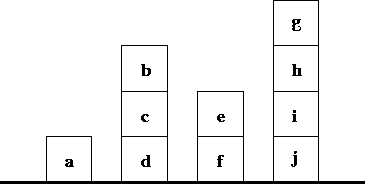
|
For this project we will only need a language having the = / 2 constraint, meaning syntactic equality. Consider a world with blocks having the setup shown in Figure 7.1. We will identify blocks with the names appearing in the picture. The following predicates will model the world:
The task to do is:
The above predicates must work for any world defined using the facts on_floor/1, on/2, and at_left/2.
Write a predicate which relates every object with its type, as shown below:
| Object | Type |
|---|---|
| a | pyramid |
| b | torus |
| c | cube |
| d | sphere |
| e | cube |
| f | torus |
| g | torus |
| h | sphere |
| i | torus |
| j | pyramid |
Using the type of each object and the predicates related to the position of objects in the world, write the following predicate:
The predicates which model the basic relationships of the world are easy to work out:
on_floor(a). on_floor(d). on_floor(f). on_floor(j). on(c, d). on(b, c). on(e, f). on(i, j). on(h, i). on(g, h). at_left(a, d). at_left(d, f). at_left(f, j).
The predicate base/2 traverses down the pile until the block directly on the floor is found:
base(X, X):- on_floor(X). base(X, Y):- on(X, Z), base(Z, Y).
base_at_right/2 follows the same idea as base/2, but it traverses the floor in search of contiguous blocks. We use the at_left/2 predicate (which ensures that both blocks are on the floor) and the recursion stops when both blocks are directly one at the left of the other.
base_at_right(X, Y):- at_left(X, Y). base_at_right(X, Y):- at_left(X, Z), base_at_right(Z, Y).
Identifying X and Y such that the pile of X is to the right of that of Y is done by finding which object is at the bottom of each pile, and then ensuring that the first base (Xb) is at the right of the second one (Yb).
object_at_right(X, Y):- base(X, Xb), base(Y, Yb), base_at_right(Xb, Yb).
Relating the object with its type boils down to applying the techniques discussed in Section 2.6. Using a set of predicates of the form pyramid(a)., torus(b)., and so on, could have been possible, but in that case querying for the type of a block would not have been easy.
type_of(a, pyramid). type_of(b, torus). type_of(c, cube). type_of(d, sphere). type_of(e, cube). type_of(f, torus). type_of(g, torus). type_of(h, sphere). type_of(i, torus). type_of(j, pyramid).
The predicate for instability is the less straightforward one, due to the number of possible cases. We will divide the unstable objects in three cases, which summarize the possible non-stable configurations:
no_torus(O):- type_of(O, pyramid). no_torus(O):- type_of(O, cube). no_torus(O):- type_of(O, sphere). convex(O):- type_of(O, pyramid). convex(O):- type_of(O, sphere). convex(O):- type_of(O, torus), on(O, O1), type_of(O1, pyramid). unstable(O):- type_of(O, sphere), on_floor(O). unstable(O):- type_of(O, sphere), on(O, O1), type_of(O1, cube). unstable(O):- no_torus(O), on(O, O1), convex(O1).